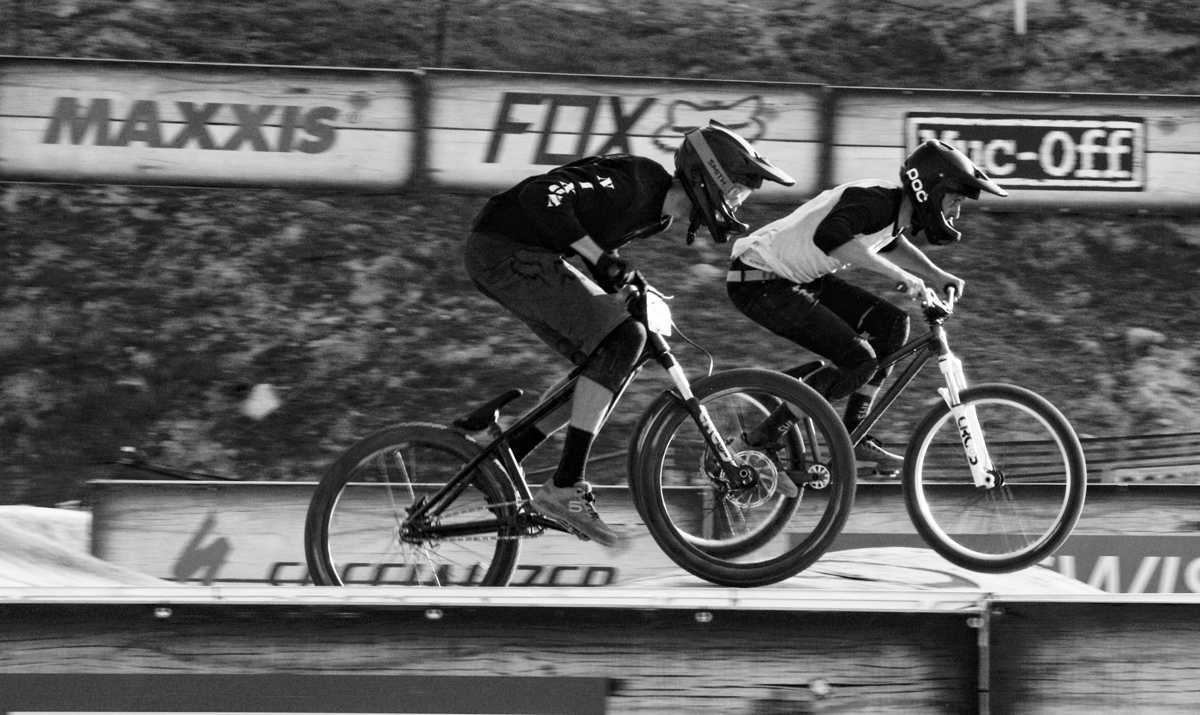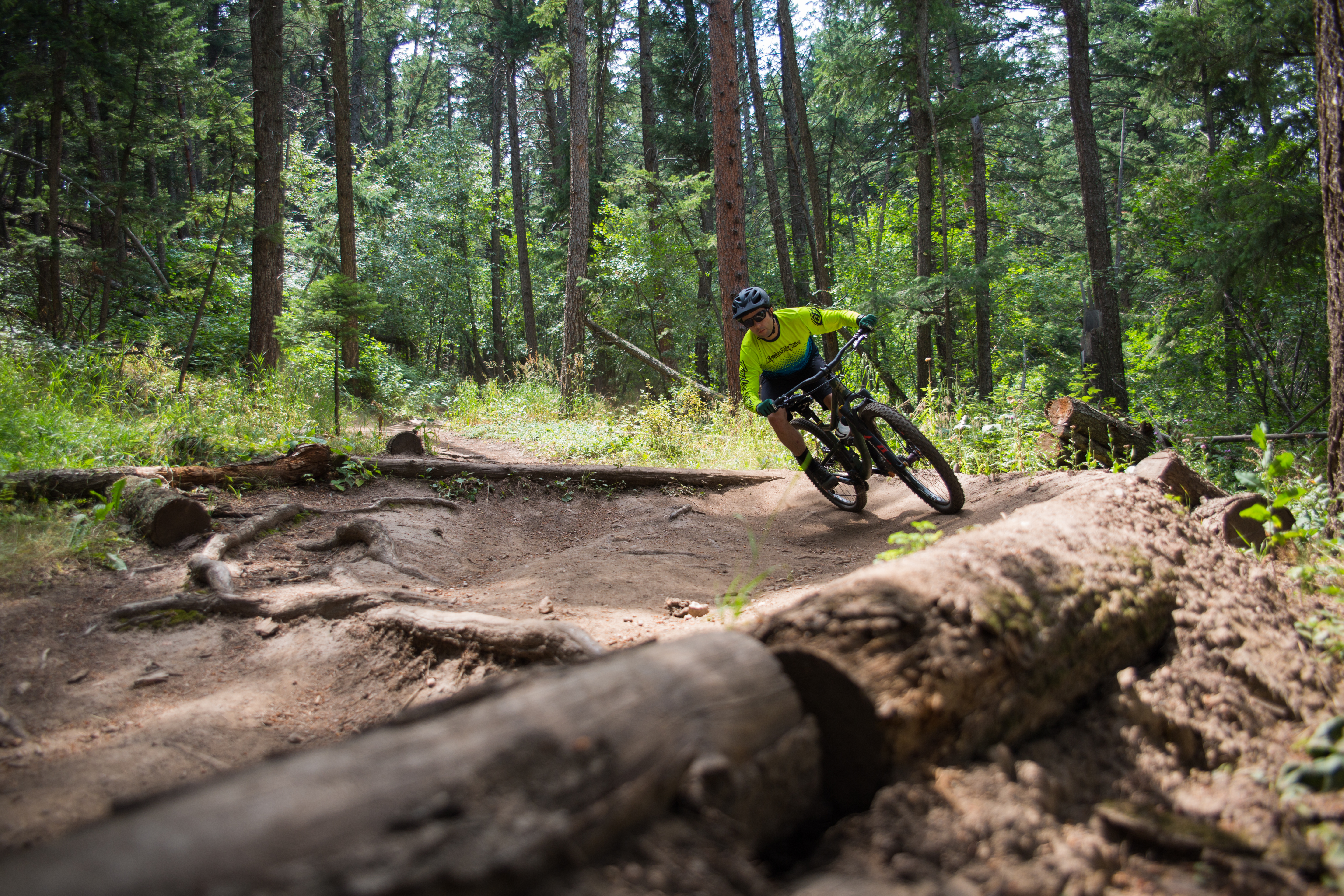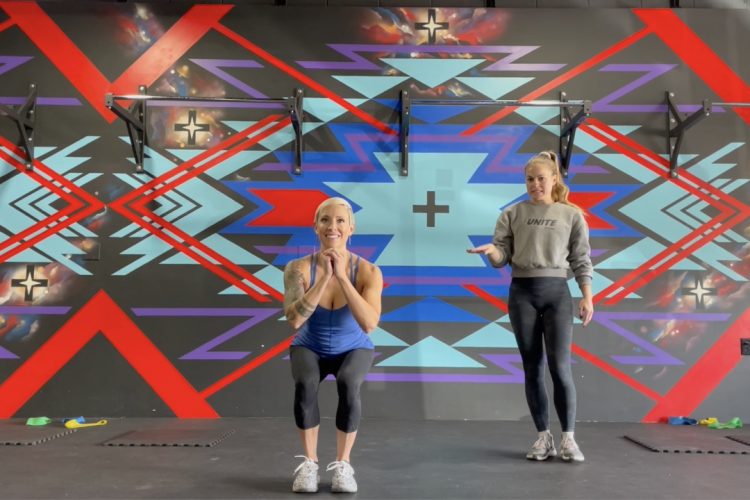
Yep, it really is that time of year again. The holidays are over and now we have a little bit of time to focus on ourselves again.
For some, that means getting in a little workout time, even if it’s off the bike. The beginning of a new year is often the best time to start. Trails aren’t in their best condition, and neither are we. For that reason, swinging some weights around for a few months before mountain bike season actually kicks off can be a great primer.
By adding some strength conditioning into our normal routine, it can equal more power and less fatigue when we ride, and also make us a little more impact resistant.
There are five to seven basic movement patterns in life. Squatting or hip-hinging, split-leg movements or lunging, pushing, pulling, and rotational movements are all the basic movement patterns that our bodies work through in life. These all translate into movement patterns on a mountain bike.
When in the climbing position, our legs are in split-leg movement and our upper-bodies are in the pushing position, holding us against the handlebars.
In the attack or downhill position, a few more movements come into play. We take a stance that is a split-squat position, are in a hip-hinge, and again, our upper bodies are mostly in the pushing position, although there is some pulling thrown in here and there, depending on the terrain and how we handle our mountain bikes.
The hips and hip-hinge movement are imperative.

When we drop into something steep, we push our hips down and get low. When we pump over rollers and jumps, our hips flex and extend, and our hips also translate power into jumping and cornering.
We’ll cover five exercises that fall into basic movement patterns and how they are related to mountain biking. Since we’re already on the topic of hips, let’s start there.
Hip-hinging (squatting and bending)

As we’ve seen now, it’s all in the hips, or at least a majority of mountain biking movement happens at the hips.
By working in a strength training movement or two we can build power and reduce fatigue that happens at the hips.
The kettlebell swing
Kettlebell swings are all about the hip hinge and building power from the hips. Pick a suitable weight to start with. On the lighter end, that may be 10 or 15 pounds. Make sure to properly warm up before performing this exercise.
Start in a bent over position with the kettlebell near the ground, held with both hands. Your feet should be about hip-width apart, or a little bit wider, and have a slight bend in the knees.
This isn’t about bending over, it’s about keeping a straight back and pushing the hips to the rear. The swing of the kettlebell is actuated by the hips flexing forward. It’s easy to get this wrong and try to squat up, while throwing the kettlebell forward, but that can put bad forces on the lumbar.
Push from your hips, to your arms and to the kettlebell. The kettlebell should come up to about shoulder height and swing back down, moving back into a hip hinge again, with the weight of the kettlebell moving back.
This is a relatively easy movement to vary, and a lighter or heavier weight can be used to start or progress. You can also add more reps or time to progress.
The squat

A proper squat also isn’t just about lowering your body down, but more so about pushing your hips back.
A normal squat starts by placing the feet hip-width apart, but variations can be made by widening or narrowing your stance.
Push your hips back, keep your knees over your ankles, and your thighs should be parallel to the ground in the squatted position, with a straight line from your butt to the crown of your head.
Progress the squat by adding more reps, holding a weight, or taking away stability with a Bosu ball.

Exercising on a Bosu ball or unstable platform has the potential to improve muscle recruitment for faster response times and reduces the chance of injury in the long-term.
Pushing

Pushing movements happen more than we think about in our daily lives. Whether it’s pushing a door open, airing our tires up before a ride, or controlling a mountain bike down a steep, technical descent.
Pushups just so happen to be an excellent choice for improving the strength in our pushing muscles, which include triceps, shoulders, and pectorals, and there are a ton of variations to make the pushup an easy starting place, or a serious challenge.
For a quick recap on the pushup, a basic pushup position starts in a high plank, with hands directly under our shoulders, and a straight line from the crown of the head down to our heels. Slowly lowering down, our chest should lower down and align with our planted hands. The basic movement of the pushup is the same, no matter the variation.
Pushups can be performed with less resistance by starting from the knees, or by starting on an incline.
To progress the movement, it can be done at a decline. To progress a pushup even more, take away stability, as this will be the closest replication to the movements your muscles perform when riding.

Doing a pushup on a Bosu ball or suspension straps adds instability into the movement.
Progression can also be achieved by adding more reps, or by doing a bench press with more weight. For those who struggle with a full high-plank pushup, a lightweight bench press is also a good place to start since you can start with less weight than would be required for a pushup.
Pulling

The row is the peanut butter to the pushup’s jelly. Our pulling and pushing muscles work synergistically on descents, especially in technical areas when the bike is rocking back and forth down steep sections.
Pulling muscles also take control on wheelies, manuals, and when we’re working to climb up steep trail and pull our upper body into the bike. You don’t need to have lats like Mr. Olympia, but it’ll add to your technical fitness and ability.
A basic row can be performed on a horizontal bar, or bent over in a hip-hinge with a barbell, or on a set of suspension straps, or with dumbbells. Hip-hinging is important for any rows performed with dumbbells or barbells, or from a standing position.
On suspension straps and under a bar, your hips stay bridged and pushed forward.
With a barbell or dumbbell, you’ll start in a similar position to the kettlebell swing, with the hips pushed back in a hinge, and the weight hanging straight down. The weight will come up straight into the chest, then release it slowly back down to full arm extension.
These exercises also work forearm muscles which will strengthen grip and strengthen your ability for longer, more controlled descents without forearm fatigue.
To progress the row, add more weight, or use suspension straps for less stability, or stand on a Bosu ball.
Rotating

When do we ever rotate our bodies on a bike? On every ride, every time we go around a corner! I don’t even want to think what cornering would be like if I only turned my head and arms throughout a switchback, with my shoulders and hips still facing straight.
Rotating still incorporates the hips, but this time pulls more core and abdominal muscles into the mix.
Roman or Mason twists are easy to implement anywhere with minimal equipment.
Start sitting up on the floor, with butt and heels on the ground and the upper body at a 45-degree angle. Clasp your hands together, or hold a small weight with both hands. Turn your shoulders to one side, tap your hands or the weight on the ground, and turn your shoulders to the other side. Repeat until you’re fatigued, and go for a few more sets.
To progress the twist, add more weight, lift your feet off of the ground, or try it on the round side of a Bosu ball for an even greater challenge.
Try it out
Now it’s time to put this all together for a full workout. Most of these are easy to do at home, or in a park, with minimal equipment.
Make sure to do a 15-minute warmup beforehand so you’re ready to go.
- 3 sets of 15 reps of kettlebell swings at an appropriate weight
- 3 sets of 15 bodyweight squats
- 3 sets of 15 pushups (start at incline if flat is too challenging)
- 3 sets of 15 rows (using best available equipment) with dumbbell, barbell, suspension straps, or hanging from a bar.
- 3 sets of 15 twists (hold a weight and perform for more resistance)
This workout is a basic full-body workout and will need to be progressed over time. Add weight, take away stability, go for longer, or record your best time getting through everything and try to beat it. If all goes well, you’ll notice a difference on the next ride, and all season long.





























12 Comments
Jan 4, 2019
Jan 3, 2019
Jan 3, 2019
Jun 26, 2019
Get a base and look up other exercises .
So when we do the negative part of an exercise such as going down on chin-ups or or the down part of bench or push-ups we should be 1.5x stronger . Typically a biker will be stronger on the pressing or coming back up and a bit shaky on the way down . At the end of the season we can be out of balance but will correct after a few weeks.
The Bosu ball will be shaky and will help stabilize muscles and better power output.
I like push-ups on the bosu ball with my feet on a Swiss ball but that is advanced and dangerous unless you build up to it.
Any plank or push-up sustained efforts will be good to give core challenges.
So working the negative restores muscle balance so I also put in leg curls on a Swiss ball because for stability challenge but mostly work the negative. Because we pull back in the pedal stroke and never do the release part.
A person can change up different exercises or change the load and reps.
I found that squats with heavy weights allow me to climb in a big gear but slow me down for pace.
Doing squats with a light weight and then immediately having benches lined up and jumping over them gives me explosive power. Of course when the gym is empty
I would alternate methods every 4 weeks and go for a circuit then other times rest between sets depending on what I felt like
Feb 8, 2019
How often should you do these excercises? I ride singletrack 2-3 times per week (2 short mid-week early morning rides + longer ride with mates in the weekend), I also like to swim, so 1-2 swim sessions a week. Should I drop a ride or swim? Or add it to the mix?
Thanks Shayne
Feb 8, 2019
Jan 3, 2019
Jan 4, 2019
Jan 4, 2019
Jan 4, 2019
As stated above - "For those who struggle with a full high-plank pushup, a lightweight bench press is also a good place to start since you can start with less weight than would be required for a pushup."
In my years as a personal trainer, I never struggled to find a pushing exercise for anyone who didn't have the strength to do a pushup from a full plank position. I used bench presses, incline presses, incline pushups, pushups from the knees, and incline pushups from suspension straps and found that most everyone was able to progress to a full, high plank pushup eventually.
Jan 4, 2019
Jan 4, 2019